Reason for the Occurrence of Chronic Kidney Disease
VerifiedAdded on 2022/08/21
|9
|1745
|13
AI Summary
Contribute Materials
Your contribution can guide someone’s learning journey. Share your
documents today.

Running head: CHRONIC KIDNEY DISEASE
CHRONIC KIDNEY DISEASE
Name of the Student
Name of the University
Author note
CHRONIC KIDNEY DISEASE
Name of the Student
Name of the University
Author note
Secure Best Marks with AI Grader
Need help grading? Try our AI Grader for instant feedback on your assignments.
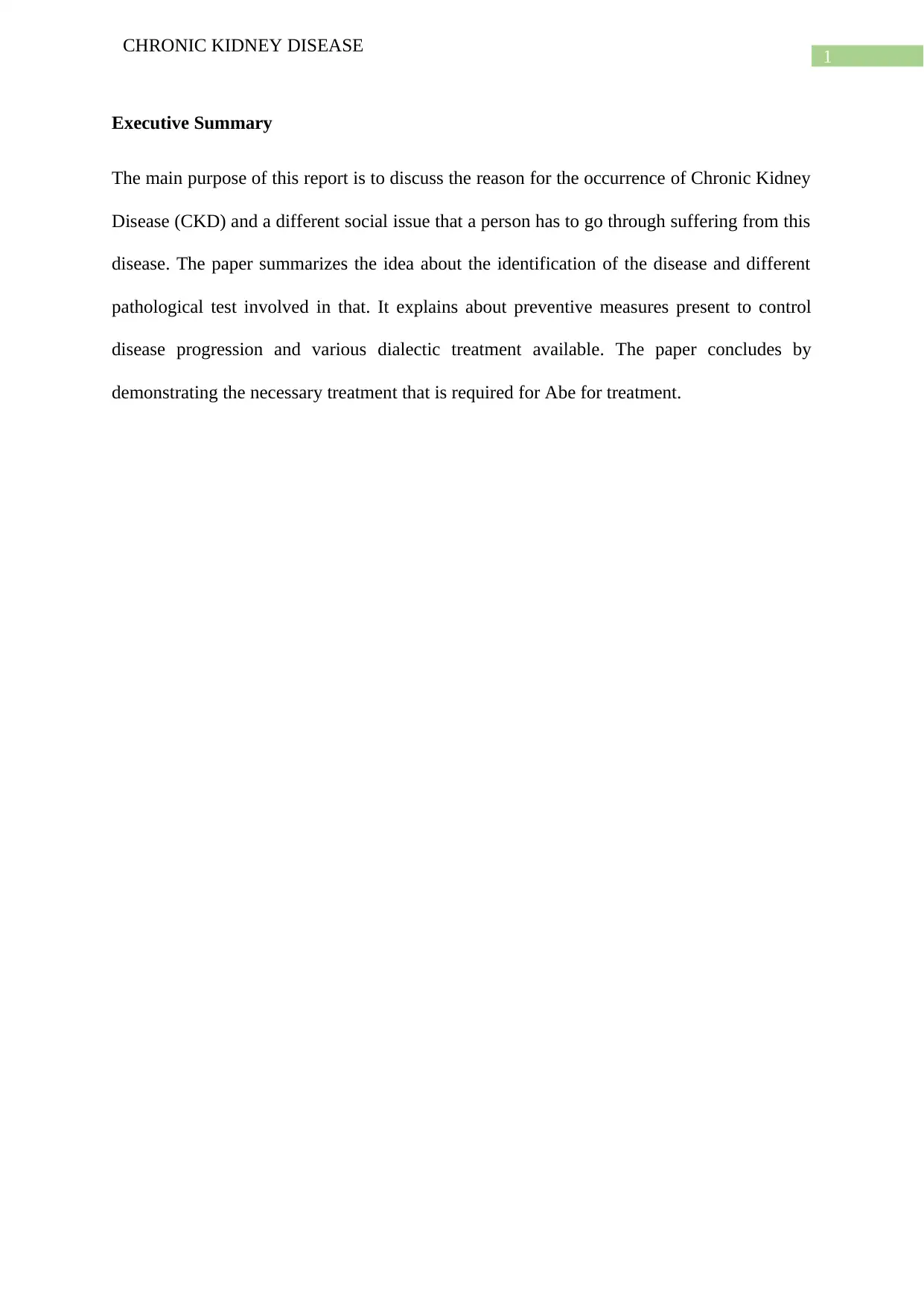
1
CHRONIC KIDNEY DISEASE
Executive Summary
The main purpose of this report is to discuss the reason for the occurrence of Chronic Kidney
Disease (CKD) and a different social issue that a person has to go through suffering from this
disease. The paper summarizes the idea about the identification of the disease and different
pathological test involved in that. It explains about preventive measures present to control
disease progression and various dialectic treatment available. The paper concludes by
demonstrating the necessary treatment that is required for Abe for treatment.
CHRONIC KIDNEY DISEASE
Executive Summary
The main purpose of this report is to discuss the reason for the occurrence of Chronic Kidney
Disease (CKD) and a different social issue that a person has to go through suffering from this
disease. The paper summarizes the idea about the identification of the disease and different
pathological test involved in that. It explains about preventive measures present to control
disease progression and various dialectic treatment available. The paper concludes by
demonstrating the necessary treatment that is required for Abe for treatment.
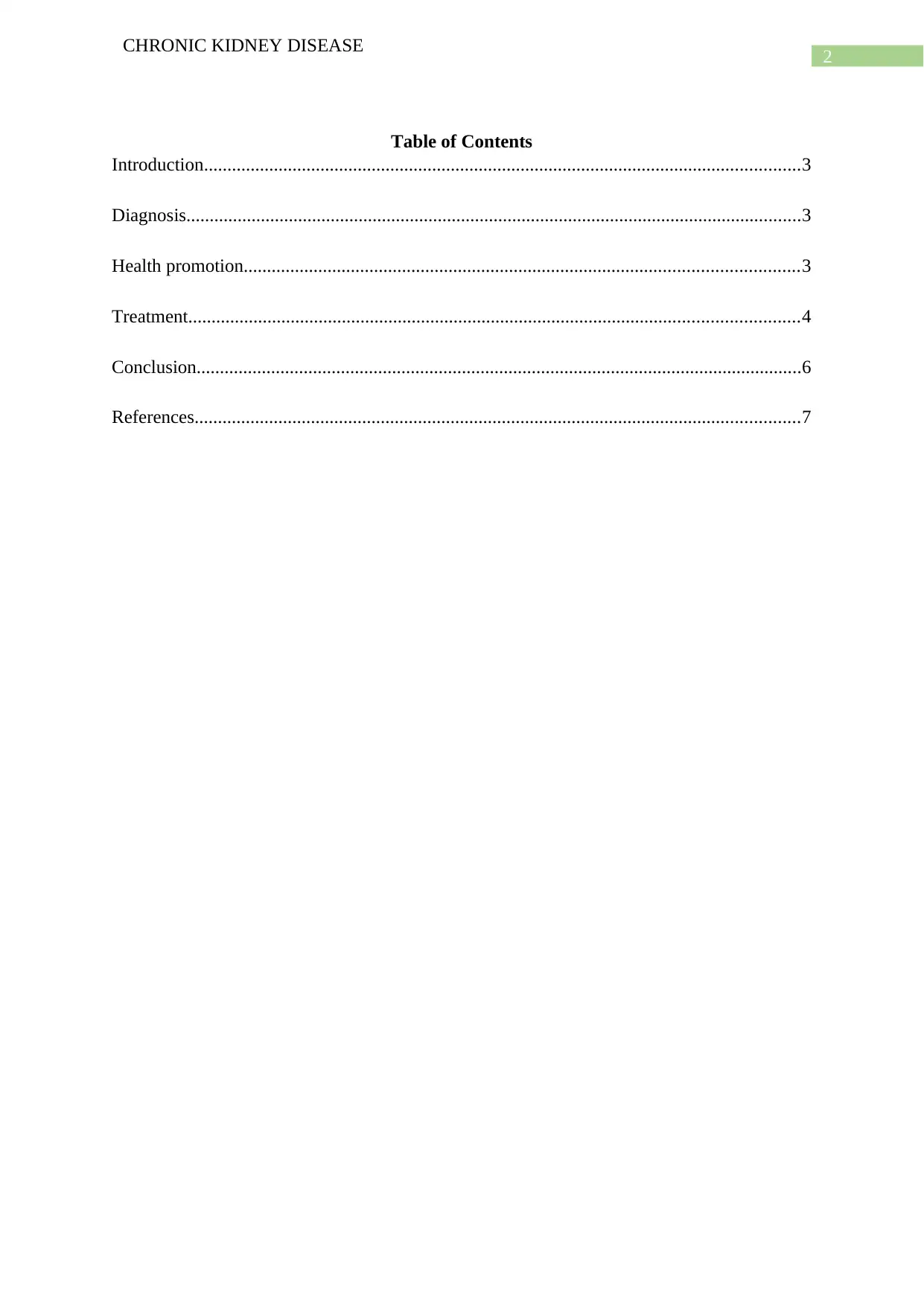
2
CHRONIC KIDNEY DISEASE
Table of Contents
Introduction................................................................................................................................3
Diagnosis....................................................................................................................................3
Health promotion.......................................................................................................................3
Treatment...................................................................................................................................4
Conclusion..................................................................................................................................6
References..................................................................................................................................7
CHRONIC KIDNEY DISEASE
Table of Contents
Introduction................................................................................................................................3
Diagnosis....................................................................................................................................3
Health promotion.......................................................................................................................3
Treatment...................................................................................................................................4
Conclusion..................................................................................................................................6
References..................................................................................................................................7
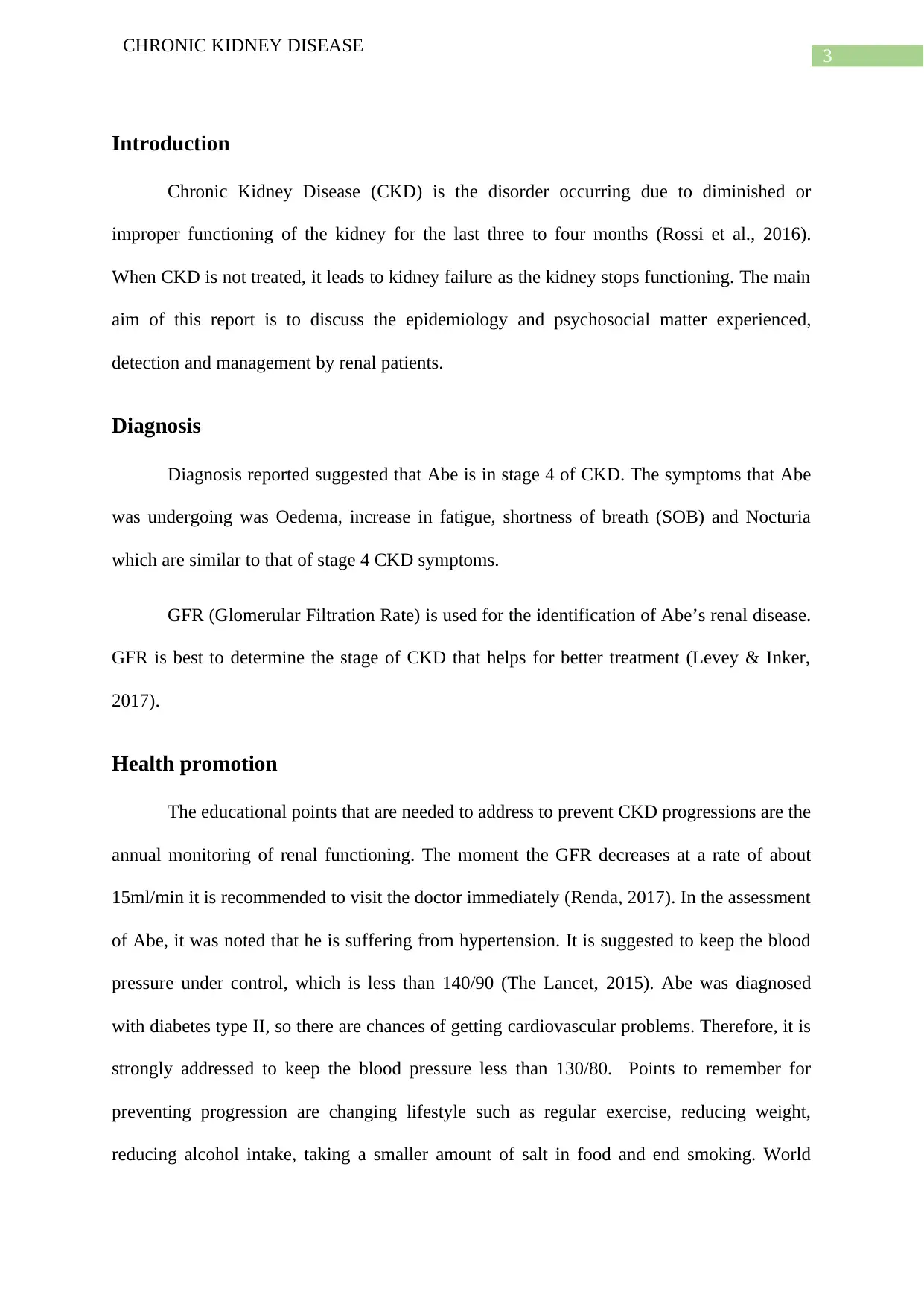
3
CHRONIC KIDNEY DISEASE
Introduction
Chronic Kidney Disease (CKD) is the disorder occurring due to diminished or
improper functioning of the kidney for the last three to four months (Rossi et al., 2016).
When CKD is not treated, it leads to kidney failure as the kidney stops functioning. The main
aim of this report is to discuss the epidemiology and psychosocial matter experienced,
detection and management by renal patients.
Diagnosis
Diagnosis reported suggested that Abe is in stage 4 of CKD. The symptoms that Abe
was undergoing was Oedema, increase in fatigue, shortness of breath (SOB) and Nocturia
which are similar to that of stage 4 CKD symptoms.
GFR (Glomerular Filtration Rate) is used for the identification of Abe’s renal disease.
GFR is best to determine the stage of CKD that helps for better treatment (Levey & Inker,
2017).
Health promotion
The educational points that are needed to address to prevent CKD progressions are the
annual monitoring of renal functioning. The moment the GFR decreases at a rate of about
15ml/min it is recommended to visit the doctor immediately (Renda, 2017). In the assessment
of Abe, it was noted that he is suffering from hypertension. It is suggested to keep the blood
pressure under control, which is less than 140/90 (The Lancet, 2015). Abe was diagnosed
with diabetes type II, so there are chances of getting cardiovascular problems. Therefore, it is
strongly addressed to keep the blood pressure less than 130/80. Points to remember for
preventing progression are changing lifestyle such as regular exercise, reducing weight,
reducing alcohol intake, taking a smaller amount of salt in food and end smoking. World
CHRONIC KIDNEY DISEASE
Introduction
Chronic Kidney Disease (CKD) is the disorder occurring due to diminished or
improper functioning of the kidney for the last three to four months (Rossi et al., 2016).
When CKD is not treated, it leads to kidney failure as the kidney stops functioning. The main
aim of this report is to discuss the epidemiology and psychosocial matter experienced,
detection and management by renal patients.
Diagnosis
Diagnosis reported suggested that Abe is in stage 4 of CKD. The symptoms that Abe
was undergoing was Oedema, increase in fatigue, shortness of breath (SOB) and Nocturia
which are similar to that of stage 4 CKD symptoms.
GFR (Glomerular Filtration Rate) is used for the identification of Abe’s renal disease.
GFR is best to determine the stage of CKD that helps for better treatment (Levey & Inker,
2017).
Health promotion
The educational points that are needed to address to prevent CKD progressions are the
annual monitoring of renal functioning. The moment the GFR decreases at a rate of about
15ml/min it is recommended to visit the doctor immediately (Renda, 2017). In the assessment
of Abe, it was noted that he is suffering from hypertension. It is suggested to keep the blood
pressure under control, which is less than 140/90 (The Lancet, 2015). Abe was diagnosed
with diabetes type II, so there are chances of getting cardiovascular problems. Therefore, it is
strongly addressed to keep the blood pressure less than 130/80. Points to remember for
preventing progression are changing lifestyle such as regular exercise, reducing weight,
reducing alcohol intake, taking a smaller amount of salt in food and end smoking. World
Secure Best Marks with AI Grader
Need help grading? Try our AI Grader for instant feedback on your assignments.
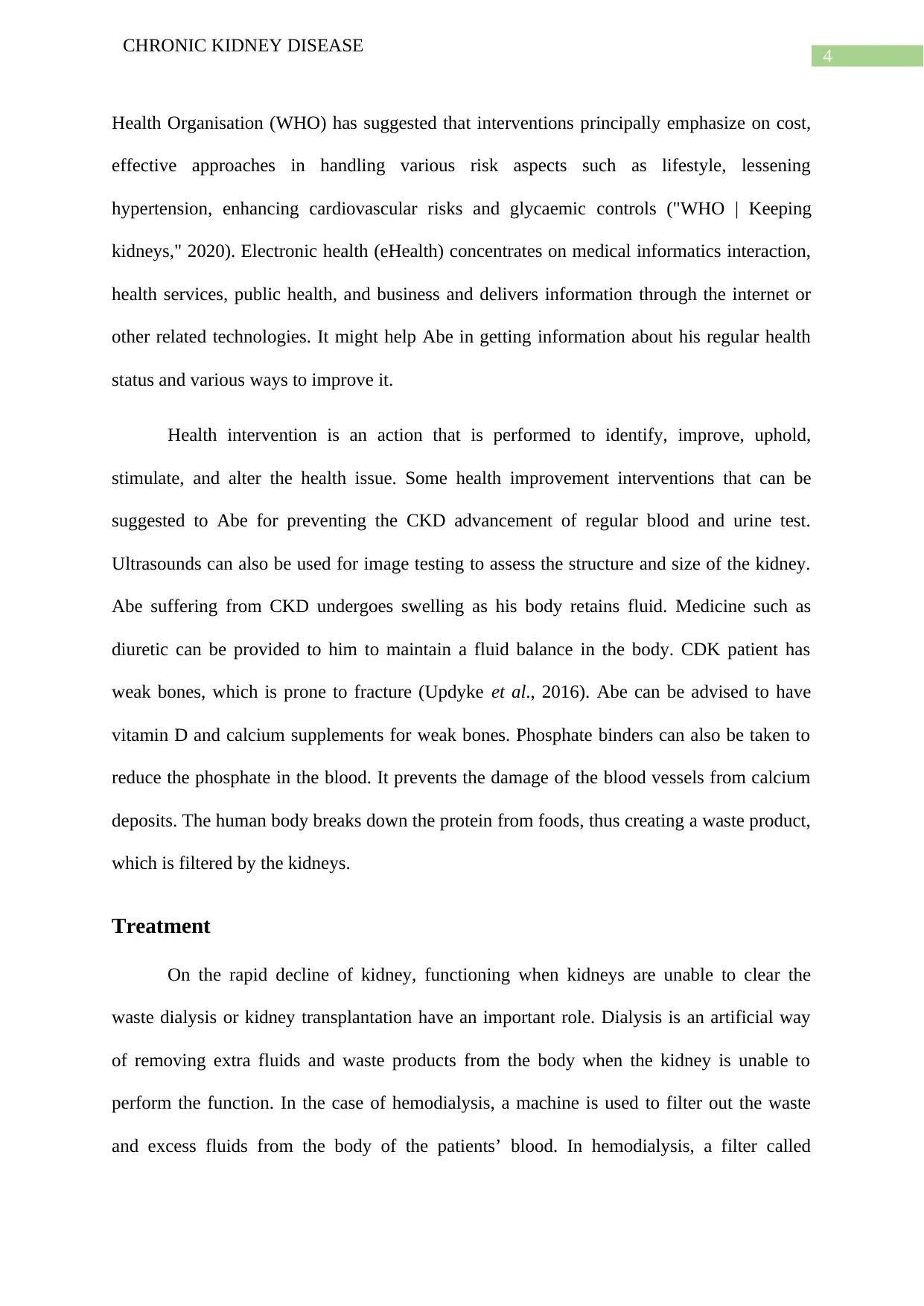
4
CHRONIC KIDNEY DISEASE
Health Organisation (WHO) has suggested that interventions principally emphasize on cost,
effective approaches in handling various risk aspects such as lifestyle, lessening
hypertension, enhancing cardiovascular risks and glycaemic controls ("WHO | Keeping
kidneys," 2020). Electronic health (eHealth) concentrates on medical informatics interaction,
health services, public health, and business and delivers information through the internet or
other related technologies. It might help Abe in getting information about his regular health
status and various ways to improve it.
Health intervention is an action that is performed to identify, improve, uphold,
stimulate, and alter the health issue. Some health improvement interventions that can be
suggested to Abe for preventing the CKD advancement of regular blood and urine test.
Ultrasounds can also be used for image testing to assess the structure and size of the kidney.
Abe suffering from CKD undergoes swelling as his body retains fluid. Medicine such as
diuretic can be provided to him to maintain a fluid balance in the body. CDK patient has
weak bones, which is prone to fracture (Updyke et al., 2016). Abe can be advised to have
vitamin D and calcium supplements for weak bones. Phosphate binders can also be taken to
reduce the phosphate in the blood. It prevents the damage of the blood vessels from calcium
deposits. The human body breaks down the protein from foods, thus creating a waste product,
which is filtered by the kidneys.
Treatment
On the rapid decline of kidney, functioning when kidneys are unable to clear the
waste dialysis or kidney transplantation have an important role. Dialysis is an artificial way
of removing extra fluids and waste products from the body when the kidney is unable to
perform the function. In the case of hemodialysis, a machine is used to filter out the waste
and excess fluids from the body of the patients’ blood. In hemodialysis, a filter called
CHRONIC KIDNEY DISEASE
Health Organisation (WHO) has suggested that interventions principally emphasize on cost,
effective approaches in handling various risk aspects such as lifestyle, lessening
hypertension, enhancing cardiovascular risks and glycaemic controls ("WHO | Keeping
kidneys," 2020). Electronic health (eHealth) concentrates on medical informatics interaction,
health services, public health, and business and delivers information through the internet or
other related technologies. It might help Abe in getting information about his regular health
status and various ways to improve it.
Health intervention is an action that is performed to identify, improve, uphold,
stimulate, and alter the health issue. Some health improvement interventions that can be
suggested to Abe for preventing the CKD advancement of regular blood and urine test.
Ultrasounds can also be used for image testing to assess the structure and size of the kidney.
Abe suffering from CKD undergoes swelling as his body retains fluid. Medicine such as
diuretic can be provided to him to maintain a fluid balance in the body. CDK patient has
weak bones, which is prone to fracture (Updyke et al., 2016). Abe can be advised to have
vitamin D and calcium supplements for weak bones. Phosphate binders can also be taken to
reduce the phosphate in the blood. It prevents the damage of the blood vessels from calcium
deposits. The human body breaks down the protein from foods, thus creating a waste product,
which is filtered by the kidneys.
Treatment
On the rapid decline of kidney, functioning when kidneys are unable to clear the
waste dialysis or kidney transplantation have an important role. Dialysis is an artificial way
of removing extra fluids and waste products from the body when the kidney is unable to
perform the function. In the case of hemodialysis, a machine is used to filter out the waste
and excess fluids from the body of the patients’ blood. In hemodialysis, a filter called
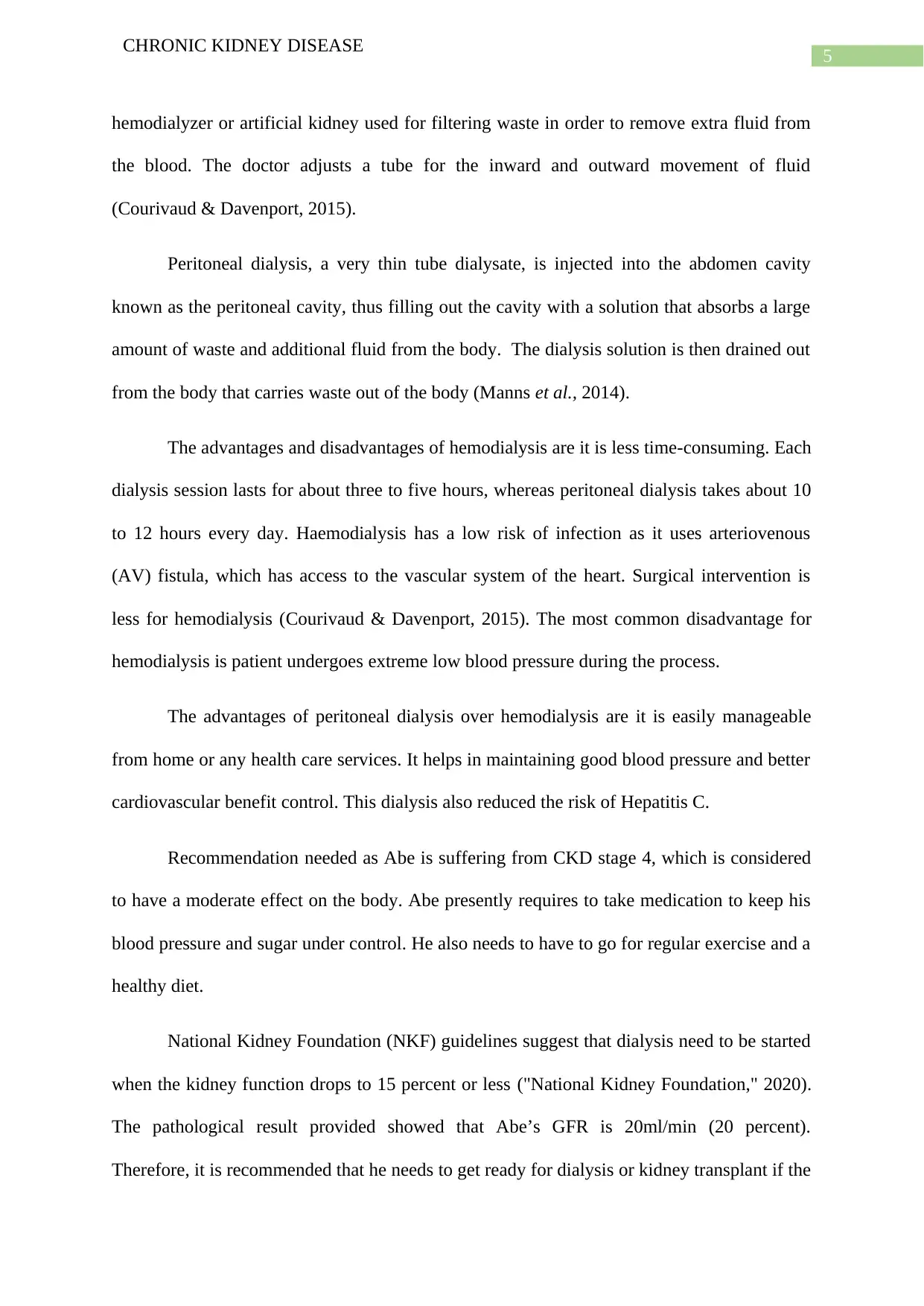
5
CHRONIC KIDNEY DISEASE
hemodialyzer or artificial kidney used for filtering waste in order to remove extra fluid from
the blood. The doctor adjusts a tube for the inward and outward movement of fluid
(Courivaud & Davenport, 2015).
Peritoneal dialysis, a very thin tube dialysate, is injected into the abdomen cavity
known as the peritoneal cavity, thus filling out the cavity with a solution that absorbs a large
amount of waste and additional fluid from the body. The dialysis solution is then drained out
from the body that carries waste out of the body (Manns et al., 2014).
The advantages and disadvantages of hemodialysis are it is less time-consuming. Each
dialysis session lasts for about three to five hours, whereas peritoneal dialysis takes about 10
to 12 hours every day. Haemodialysis has a low risk of infection as it uses arteriovenous
(AV) fistula, which has access to the vascular system of the heart. Surgical intervention is
less for hemodialysis (Courivaud & Davenport, 2015). The most common disadvantage for
hemodialysis is patient undergoes extreme low blood pressure during the process.
The advantages of peritoneal dialysis over hemodialysis are it is easily manageable
from home or any health care services. It helps in maintaining good blood pressure and better
cardiovascular benefit control. This dialysis also reduced the risk of Hepatitis C.
Recommendation needed as Abe is suffering from CKD stage 4, which is considered
to have a moderate effect on the body. Abe presently requires to take medication to keep his
blood pressure and sugar under control. He also needs to have to go for regular exercise and a
healthy diet.
National Kidney Foundation (NKF) guidelines suggest that dialysis need to be started
when the kidney function drops to 15 percent or less ("National Kidney Foundation," 2020).
The pathological result provided showed that Abe’s GFR is 20ml/min (20 percent).
Therefore, it is recommended that he needs to get ready for dialysis or kidney transplant if the
CHRONIC KIDNEY DISEASE
hemodialyzer or artificial kidney used for filtering waste in order to remove extra fluid from
the blood. The doctor adjusts a tube for the inward and outward movement of fluid
(Courivaud & Davenport, 2015).
Peritoneal dialysis, a very thin tube dialysate, is injected into the abdomen cavity
known as the peritoneal cavity, thus filling out the cavity with a solution that absorbs a large
amount of waste and additional fluid from the body. The dialysis solution is then drained out
from the body that carries waste out of the body (Manns et al., 2014).
The advantages and disadvantages of hemodialysis are it is less time-consuming. Each
dialysis session lasts for about three to five hours, whereas peritoneal dialysis takes about 10
to 12 hours every day. Haemodialysis has a low risk of infection as it uses arteriovenous
(AV) fistula, which has access to the vascular system of the heart. Surgical intervention is
less for hemodialysis (Courivaud & Davenport, 2015). The most common disadvantage for
hemodialysis is patient undergoes extreme low blood pressure during the process.
The advantages of peritoneal dialysis over hemodialysis are it is easily manageable
from home or any health care services. It helps in maintaining good blood pressure and better
cardiovascular benefit control. This dialysis also reduced the risk of Hepatitis C.
Recommendation needed as Abe is suffering from CKD stage 4, which is considered
to have a moderate effect on the body. Abe presently requires to take medication to keep his
blood pressure and sugar under control. He also needs to have to go for regular exercise and a
healthy diet.
National Kidney Foundation (NKF) guidelines suggest that dialysis need to be started
when the kidney function drops to 15 percent or less ("National Kidney Foundation," 2020).
The pathological result provided showed that Abe’s GFR is 20ml/min (20 percent).
Therefore, it is recommended that he needs to get ready for dialysis or kidney transplant if the
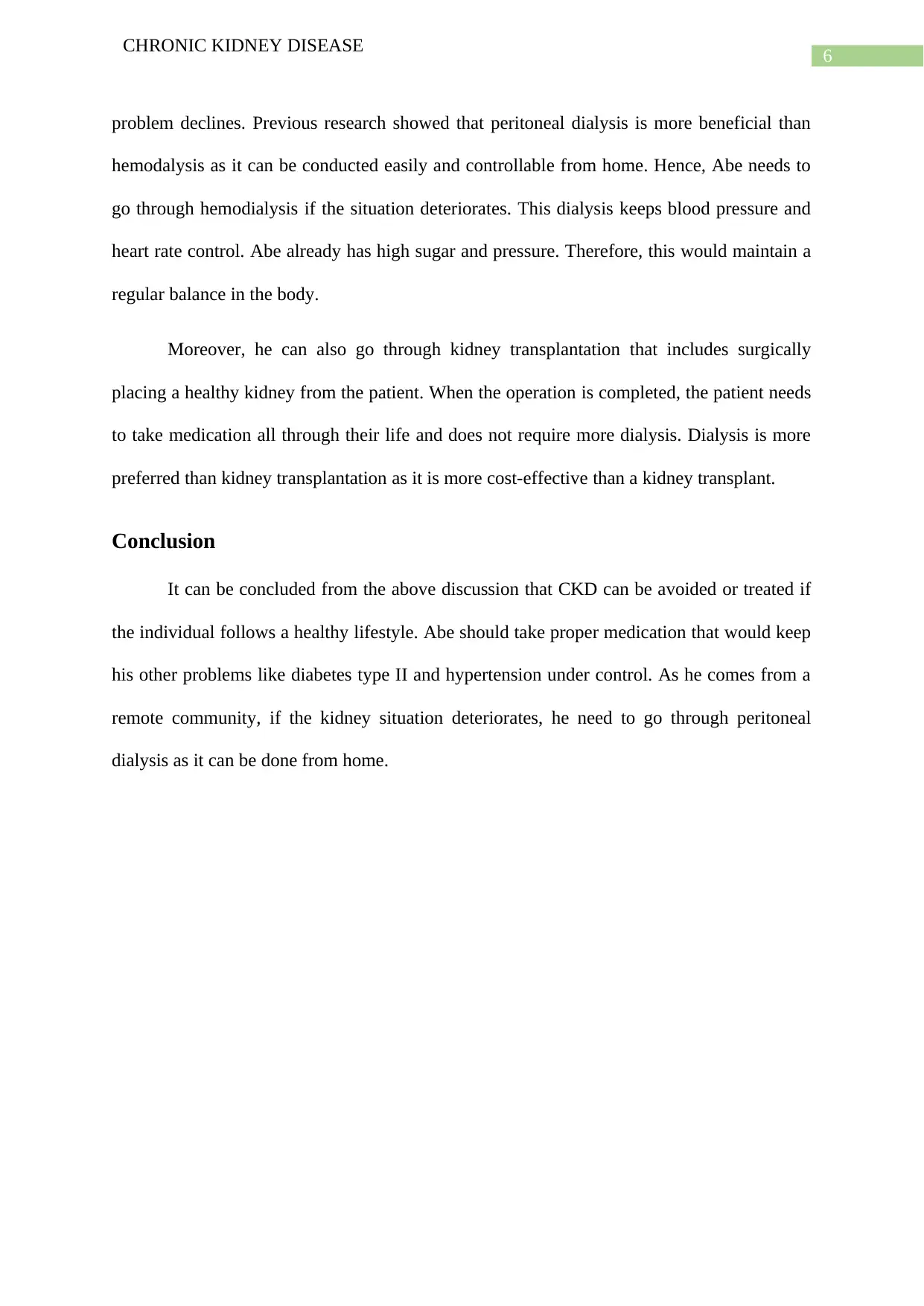
6
CHRONIC KIDNEY DISEASE
problem declines. Previous research showed that peritoneal dialysis is more beneficial than
hemodalysis as it can be conducted easily and controllable from home. Hence, Abe needs to
go through hemodialysis if the situation deteriorates. This dialysis keeps blood pressure and
heart rate control. Abe already has high sugar and pressure. Therefore, this would maintain a
regular balance in the body.
Moreover, he can also go through kidney transplantation that includes surgically
placing a healthy kidney from the patient. When the operation is completed, the patient needs
to take medication all through their life and does not require more dialysis. Dialysis is more
preferred than kidney transplantation as it is more cost-effective than a kidney transplant.
Conclusion
It can be concluded from the above discussion that CKD can be avoided or treated if
the individual follows a healthy lifestyle. Abe should take proper medication that would keep
his other problems like diabetes type II and hypertension under control. As he comes from a
remote community, if the kidney situation deteriorates, he need to go through peritoneal
dialysis as it can be done from home.
CHRONIC KIDNEY DISEASE
problem declines. Previous research showed that peritoneal dialysis is more beneficial than
hemodalysis as it can be conducted easily and controllable from home. Hence, Abe needs to
go through hemodialysis if the situation deteriorates. This dialysis keeps blood pressure and
heart rate control. Abe already has high sugar and pressure. Therefore, this would maintain a
regular balance in the body.
Moreover, he can also go through kidney transplantation that includes surgically
placing a healthy kidney from the patient. When the operation is completed, the patient needs
to take medication all through their life and does not require more dialysis. Dialysis is more
preferred than kidney transplantation as it is more cost-effective than a kidney transplant.
Conclusion
It can be concluded from the above discussion that CKD can be avoided or treated if
the individual follows a healthy lifestyle. Abe should take proper medication that would keep
his other problems like diabetes type II and hypertension under control. As he comes from a
remote community, if the kidney situation deteriorates, he need to go through peritoneal
dialysis as it can be done from home.
Paraphrase This Document
Need a fresh take? Get an instant paraphrase of this document with our AI Paraphraser
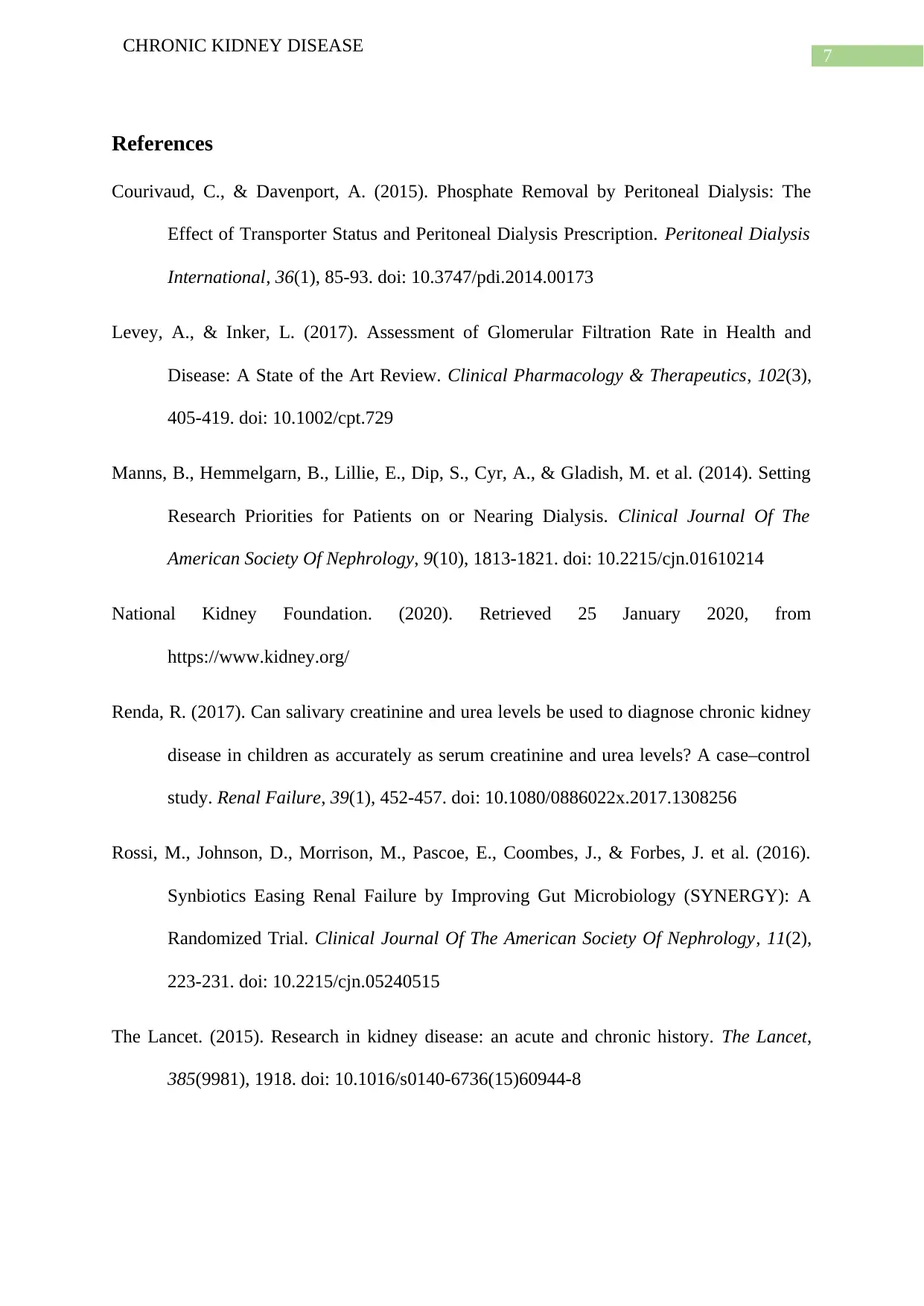
7
CHRONIC KIDNEY DISEASE
References
Courivaud, C., & Davenport, A. (2015). Phosphate Removal by Peritoneal Dialysis: The
Effect of Transporter Status and Peritoneal Dialysis Prescription. Peritoneal Dialysis
International, 36(1), 85-93. doi: 10.3747/pdi.2014.00173
Levey, A., & Inker, L. (2017). Assessment of Glomerular Filtration Rate in Health and
Disease: A State of the Art Review. Clinical Pharmacology & Therapeutics, 102(3),
405-419. doi: 10.1002/cpt.729
Manns, B., Hemmelgarn, B., Lillie, E., Dip, S., Cyr, A., & Gladish, M. et al. (2014). Setting
Research Priorities for Patients on or Nearing Dialysis. Clinical Journal Of The
American Society Of Nephrology, 9(10), 1813-1821. doi: 10.2215/cjn.01610214
National Kidney Foundation. (2020). Retrieved 25 January 2020, from
https://www.kidney.org/
Renda, R. (2017). Can salivary creatinine and urea levels be used to diagnose chronic kidney
disease in children as accurately as serum creatinine and urea levels? A case–control
study. Renal Failure, 39(1), 452-457. doi: 10.1080/0886022x.2017.1308256
Rossi, M., Johnson, D., Morrison, M., Pascoe, E., Coombes, J., & Forbes, J. et al. (2016).
Synbiotics Easing Renal Failure by Improving Gut Microbiology (SYNERGY): A
Randomized Trial. Clinical Journal Of The American Society Of Nephrology, 11(2),
223-231. doi: 10.2215/cjn.05240515
The Lancet. (2015). Research in kidney disease: an acute and chronic history. The Lancet,
385(9981), 1918. doi: 10.1016/s0140-6736(15)60944-8
CHRONIC KIDNEY DISEASE
References
Courivaud, C., & Davenport, A. (2015). Phosphate Removal by Peritoneal Dialysis: The
Effect of Transporter Status and Peritoneal Dialysis Prescription. Peritoneal Dialysis
International, 36(1), 85-93. doi: 10.3747/pdi.2014.00173
Levey, A., & Inker, L. (2017). Assessment of Glomerular Filtration Rate in Health and
Disease: A State of the Art Review. Clinical Pharmacology & Therapeutics, 102(3),
405-419. doi: 10.1002/cpt.729
Manns, B., Hemmelgarn, B., Lillie, E., Dip, S., Cyr, A., & Gladish, M. et al. (2014). Setting
Research Priorities for Patients on or Nearing Dialysis. Clinical Journal Of The
American Society Of Nephrology, 9(10), 1813-1821. doi: 10.2215/cjn.01610214
National Kidney Foundation. (2020). Retrieved 25 January 2020, from
https://www.kidney.org/
Renda, R. (2017). Can salivary creatinine and urea levels be used to diagnose chronic kidney
disease in children as accurately as serum creatinine and urea levels? A case–control
study. Renal Failure, 39(1), 452-457. doi: 10.1080/0886022x.2017.1308256
Rossi, M., Johnson, D., Morrison, M., Pascoe, E., Coombes, J., & Forbes, J. et al. (2016).
Synbiotics Easing Renal Failure by Improving Gut Microbiology (SYNERGY): A
Randomized Trial. Clinical Journal Of The American Society Of Nephrology, 11(2),
223-231. doi: 10.2215/cjn.05240515
The Lancet. (2015). Research in kidney disease: an acute and chronic history. The Lancet,
385(9981), 1918. doi: 10.1016/s0140-6736(15)60944-8
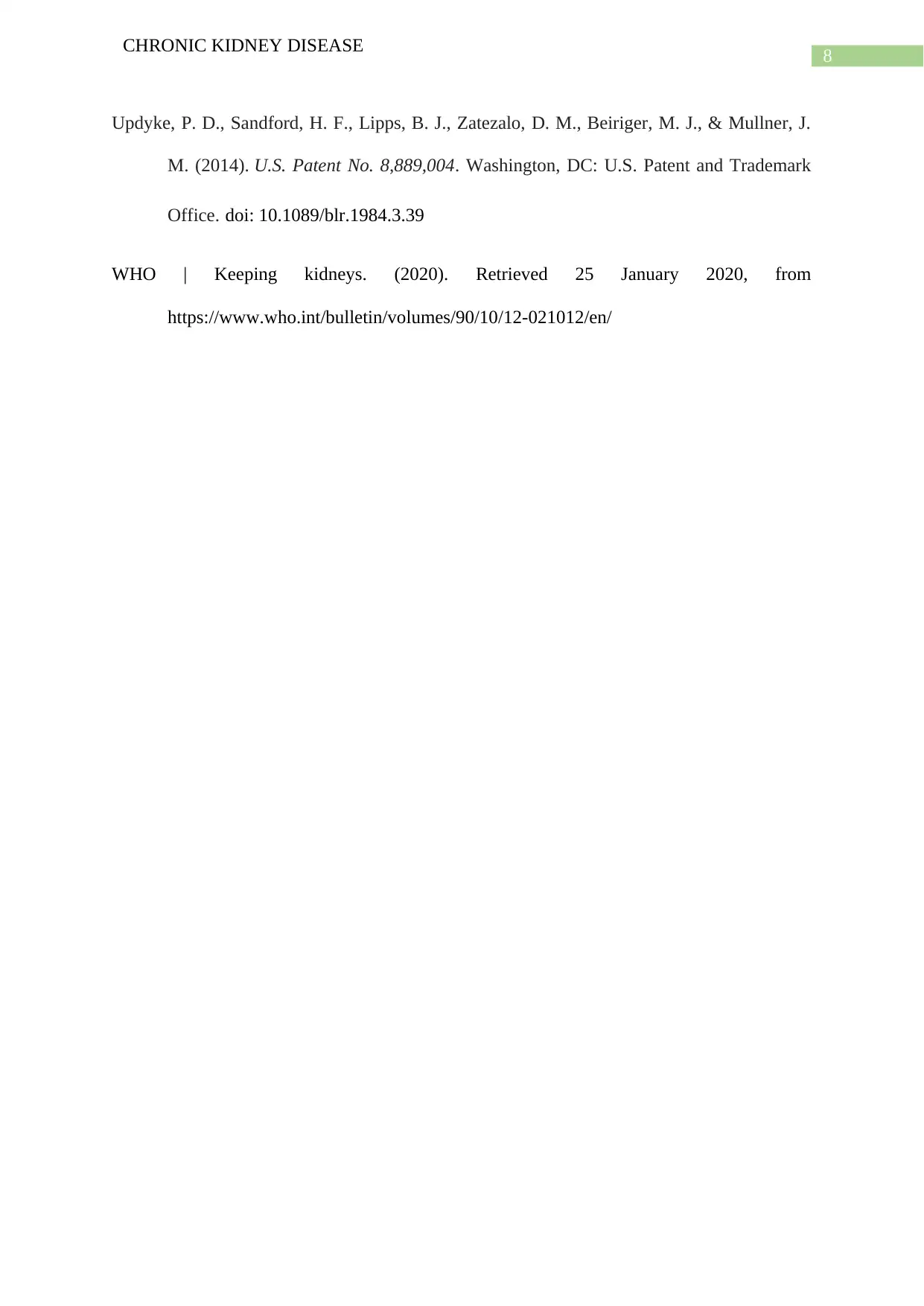
8
CHRONIC KIDNEY DISEASE
Updyke, P. D., Sandford, H. F., Lipps, B. J., Zatezalo, D. M., Beiriger, M. J., & Mullner, J.
M. (2014). U.S. Patent No. 8,889,004. Washington, DC: U.S. Patent and Trademark
Office. doi: 10.1089/blr.1984.3.39
WHO | Keeping kidneys. (2020). Retrieved 25 January 2020, from
https://www.who.int/bulletin/volumes/90/10/12-021012/en/
CHRONIC KIDNEY DISEASE
Updyke, P. D., Sandford, H. F., Lipps, B. J., Zatezalo, D. M., Beiriger, M. J., & Mullner, J.
M. (2014). U.S. Patent No. 8,889,004. Washington, DC: U.S. Patent and Trademark
Office. doi: 10.1089/blr.1984.3.39
WHO | Keeping kidneys. (2020). Retrieved 25 January 2020, from
https://www.who.int/bulletin/volumes/90/10/12-021012/en/
1 out of 9
Related Documents
Your All-in-One AI-Powered Toolkit for Academic Success.
+13062052269
info@desklib.com
Available 24*7 on WhatsApp / Email
![[object Object]](/_next/static/media/star-bottom.7253800d.svg)
Unlock your academic potential
© 2024 | Zucol Services PVT LTD | All rights reserved.




